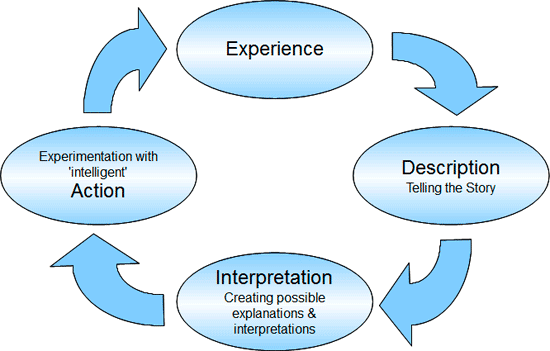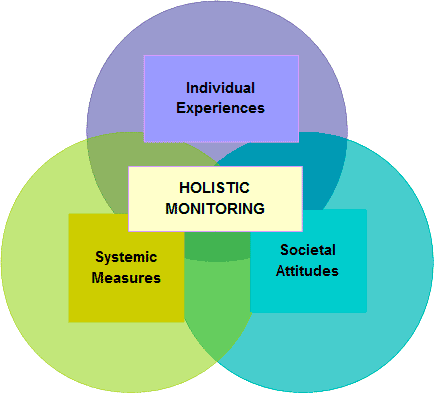ICESCR Training Guide - Module 4: Human Rights Monitoring
Facilitator Overview
Introduction
This module explores what is meant by disability rights monitoring and how understanding and collecting information about how well disability rights are being realized can achieve a better life for people with disabilities.
Description
- 4.1 Defining Monitoring: Go over the definition of human rights monitoring and discuss with the group why it is important to monitor. (10 min)
- 4.2 Focus Areas for Disability Rights Monitoring: Review the different types of monitoring and ask participants to create a role play showing how monitoring might take placein a real situation. Discuss as a group the importance of each category. (30 min)
- 4.3 Important Goals for Human Rights Monitoring: Review with participants the goals of human rights monitoring and the ways in which each goal relates to the economic, social and cultural rights of people with disabilities. (10 min)
- 4.4 Holistic Approach: Using the information provided, discuss with the group the role of a holistic approach to disability rights monitoring. (10 min)
Time: 60 minutes
Participant Overview - Module 4: Human Rights Monitoring
Objectives
This module explores what is meant by disability rights monitoring and how understanding disability rights can be used to achieve a better life for people with disabilities.
Description
So far, the training has explored the meaning of rights and the ways in which rights can be applied. This part of the training will look at the ways in which rights can be monitored to ensure that they are being implemented.
- 4.1 Defining Human Rights Monitoring (10 minutes)
- 4.2 Focus Areas for Disability Rights Monitoring (30 minutes)
- 4.3 Important Goals for Human Rights Monitoring (10 minutes)
- 4.4 Holistic Approach (10 minutes)
Time: 60 minutes
Section 4.1 – Defining Monitoring
"Monitoring" has been described as "the active collection, verification, and immediate use of information to address human rights problems. Human rights monitoring includes gathering information about incidents, observing events, visiting sites and holding discussions with government authorities to obtain information and to pursue remedies."
In other words, "monitoring" is:
- Finding out what is going on
- Fact-finding
- Asking questions
- Collecting information
- Using indicators to measure progress (An indicator can be qualitative or quantitative in nature; providing specific information on an event, activity or an outcome)
- Measuring progress toward justice for people with disabilities
- Identifying violations
- Obligations
Section 4.2 – Focus Areas for Disability Rights Monitoring
When colleting information about disability rights, there are three important sources of information:
- Individual Experiences of Persons with Disabilities
- Systemic Measures (Laws, Policies and Programs)
- Societal Attitudes about Disability (as depicted through the media)
Individual Experiences
Life experiences shared by people with disabilities regarding the barriers and challenges they have faced, experiences when they have been left out, treated badly or prevented from participating because of their disability, provide information about the actual human rights situation faced by people with disabilities. Quite often, people with disabilities do not see the point in reporting mistreatment or they fear further abuse as a result of reporting. Documenting and reporting individual cases of ill-treatment in both public and private spheres is important in raising awareness and in getting support to make change. It also makes it difficult for governments to inaccurately claim that citizens' rights are being respected.
There are many reasons why it is important to collect information about life stories and experiences of people with disabilities including:
- To raise awareness of how the rights of people with disabilities are denied
- To translate rights guarantees on paper into reality
- To expose instances and patterns of human rights violations
- To ensure that governments and other authorities are doing their job to protect, promote and fulfill human rights
- To guide public policy in promoting and protecting human rights
- To prevent violations of human rights
Human rights monitoring can uncover a country's failures but it can also highlight situations in which governments are doing a good job to promote, protect and fulfill human rights obligations. Disability rights monitoring can be a benchmark for measuring governments' progress in making the lives of people with disabilities better. We can learn a lot from both the bad examples and the good ones and this information can be shared across countries.
Systems Measures (Laws, Policies and Programs)
Laws and policies must be reviewed and compared to UN and regional standards to see whether they meet the country's obligations to respect, protect and promote human rights and to progressively implement those rights. While laws and policies may protect human rights, they may also be used in ways that create inequality and actually violate the human rights of persons with disabilities. It is important to review how laws are implemented in order to accurately assess their impact on the enjoyment of rights.
Legal cases and decisions are sometimes just as important as the written laws of a country when protecting and promoting human rights. A law can say one thing but be interpreted by courts and tribunals in a different way, leading to significant impacts on individual and group enjoyment of human rights.
Government programs, services and practices often have the greatest impact on the daily lives of persons with disabilities. Addressing the ways that government makes budgetary decisions around disability as well as documenting programs, services and practices that violate human rights – either directly or indirectly – provides evidence needed for change.
Societal Attitudes
Negative societal attitudes toward disability and persons with disabilities can significantly impact the enjoyment of rights. The media both reflects and plays a very important role in influencing public opinion. It has a tremendous impact on how people around the world think about persons with disabilities and disability issues in general. Disability imagery and coverage is tracked in print, broadcast and internet-based media to learn about societal attitudes about disability and people with disabilities. This information can be used to put individual human rights experiences and systemic measures in context and determine the efforts that should be made to combat negative stereotypes.
Activity: Role Play
Divide into 3 small groups with each group focussing on one of the 3 sources of disability rights monitoring information.
- Individual Experiences
- Systemic Measures
- Societal Attitudes
Over 20 minutes, each group will prepare a role play based on the source of monitoring information chosen. The role play should try to demonstrate an effective way to monitor the human rights of people with disabilities. Some examples are provided below.
| Area | Possible Roles to play | Possible Outcomes? |
|---|---|---|
|
Individual Experience |
You are a group responsible for interviewing people with disabilities about their experiences in Toronto. What kinds of questions would you ask? What information might be important to gather? |
|
|
Systemic (law, policy, court cases, government services) |
You are an advocacy group creating a report for your provincial government about the role of social assistance for people with disabilities. What kind of information do you want to collect? How is understanding social policy important to rights monitoring? |
|
|
Societal Attitudes |
You are researchers planning a research project about the portrayal of disability in the newspaper. What kind of information do you want to collect? Why is the newspaper an important source of information? |
Section 4.3 – Important Goals of Human Rights Monitoring
-
A sustainable human rights framework recognizes that:
- disability is a result of social, legal and economic status
- a broad set of factors contribute to exclusion and loss of human rights
- respect for diversity contributes to well-being
- people must be supported to exercise their rights
- people need a sense of fairness in their communities and societies
-
There is a need to politicize disability by:
- rejecting the assumption that an individual has to conform
- shifting from seeing the individual as the cause of his or her place in life
- recognizing the part played by social, economic and political structures
- acknowledging ways that people are included and excluded by society
- critically analyzing the wealth and power structures in society
- opposing unjust distributions of wealth and power
-
The realization that rights (not the provision of services) must be the goal of policy and practice:
- building inclusion into the design of services, supports, programs and funding allocations
- recognizing that services, supports, programs and funding allocations are not ends in themselves but are ways to achieve social & economic integration of people with disabilities and the realization of political, civil, economic, social and cultural rights.
-
There is a need to change the underlying beliefs about disability and rights by:
- ensuring that "they" become part of "us"
- recognizing and respecting people's differences
- seeing difference as the basis for making everything accessible
- acknowledging that citizenship means entitlement
- supporting the fundamental shift from classification, segregation, and obligation to human dignity, community, protection of rights and equality and inclusion
-
Changes in services and support should reflect:
- rights rather than charity
- choice rather than imposed best interests
- empowerment rather than disempowerment
- citizen participation in decision making rather than professional control
- individual need rather than "easy" labelling
- support rather than service
-
An overall inclusive framework emphasizes:
- social justice (that is, fair distribution of resources and inclusion)
- valuing diversity (recognition and respect; valuing the contributions of everyone)
- opportunities for choice
- entitlement to rights and services
- working together, using common interests as a basis for action
- Making the Changes:

Section 4.4 – Holistic Approach to Disability Rights Monitoring
Looking at each of the sources of types of monitoring information (individual experiences, systemic measures, societal attitudes) separately, provides important information about the human rights situation of people with disabilities in a particular place. But, each type of information independently is not enough. A holistic approach that examines each of the types of monitoring information in conjunction with the other two provides a more comprehensive understanding of human rights situations and takes advantage of how the areas overlap.
For example, individual experiences of people with disabilities can provide evidence of the failure of particular laws and policies to protect and promote human rights and may be impacted positively or negatively by media coverage of particular issues.
The three sources of monitoring information also suggest the multidimensional nature of a global disability rights monitoring project and the need to establish and promote communication networks not only geographically, but in other relevant sectors, such as universities, government and the general community.
DIAGRAM: Holistic Approach to Disability Rights Monitoring

Individually, each element tells us one piece of the story. Together, they give us the whole story.

